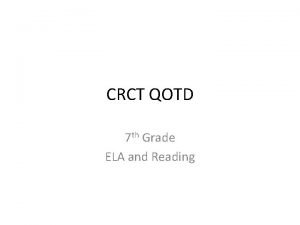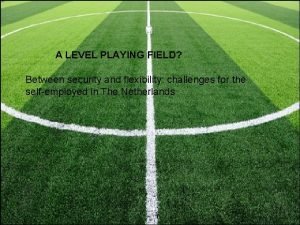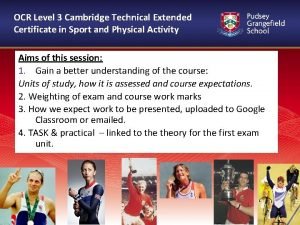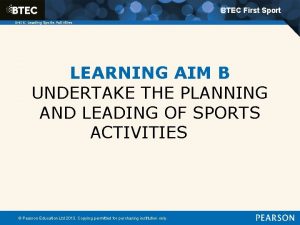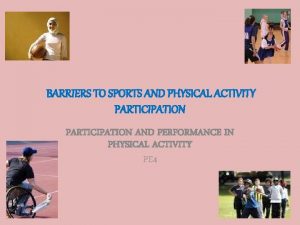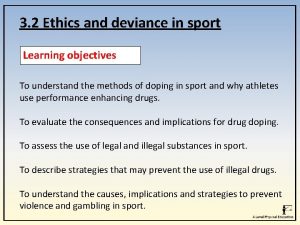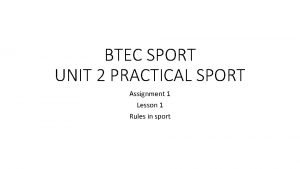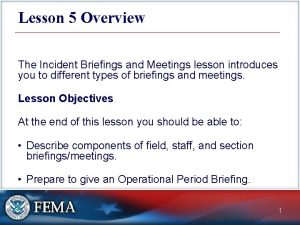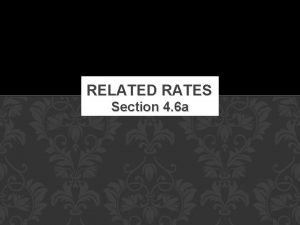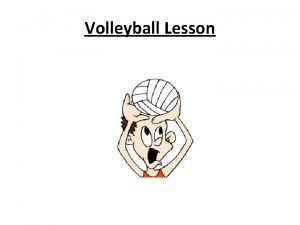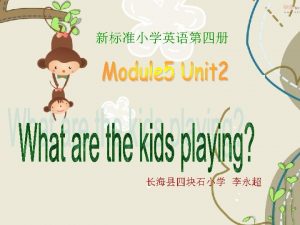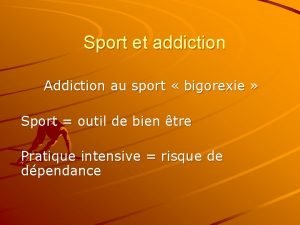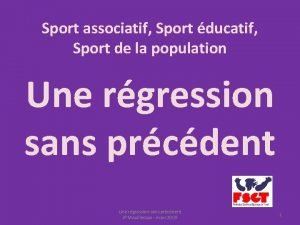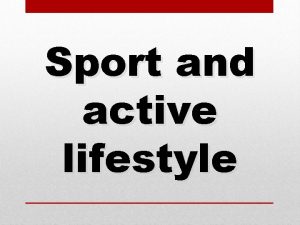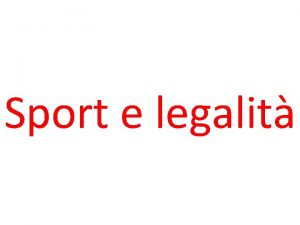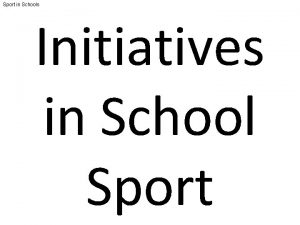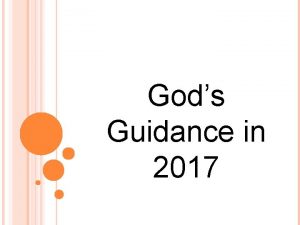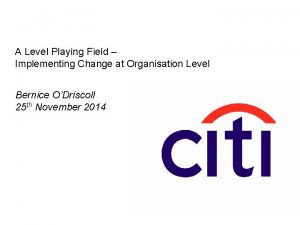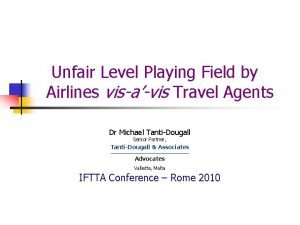Sport NI Creating a Level Playing Field Guidance



























- Slides: 27

Sport NI ‘Creating a Level Playing Field’ Guidance for Governing Bodies John Kremer March 2010

Anti-Discrimination Legislation Ø Sex Discrimination (NI) Order 1976 ØGender Recognition Act 2004 Ø Disability Discrimination Act 1995 Ø Race Relations (NI) Order 1997 Ø Fair Employment & Treatment (NI) Order 1998 Ø Equality Act (Sexual Orientation) Regulations (NI) 2006 ØExtended to goods, facilities and services Ø Employment Equality (Age) Regulations (NI) 2006 Ø Northern Ireland Act 1998 Ø Section 75 & Schedule 9 (appendix)

BOX 1: HITTING THE HEADLINES • ‘Five members of the traveller community are to receive £ 1, 000 each in compensation after a local golf club barred them from playing on its course. The case involved Dungannon Golf Club who admitted racial discrimination against the five individuals during an incident in June 2000. In the settlement the Golf Club apologised to the individuals and admitted liability saying it also accepted that its practices and procedures were unlawful. Joan Harbison, Chief Commissioner of the Equality Commission, said she was pleased with the decision. "When people think about equality they often think first about discrimination in job appointments and in the workplace. These are very important, but so too is the right of every person not to be excluded from playing sports, shopping or from a social life just because they belong to a particular group or community, " she said. ’ • (20 th August 2003; 4 NI. co. uk)

DIRECT DISCRIMINATION Less favourable treatment based on a protected characteristic. BOX 2: EXAMPLES OF DIRECT DISCRIMINATION: • Refusing to allow a team to compete or use facilities because they are from a particular community background; • Only allowing individuals of a certain age to apply for coaching qualifications; • Not permitting women to officiate at men’s competitions, or vice versa.

INDIRECT DISCRIMINATION A provision criterion or practice is applied equally but it puts people of a certain identity (e. g. religion, race, sex, age, disability) at a disadvantage and can’t be shown to be a: ‘proportionate means of achieving a legitimate aim’. BOX 3: EXAMPLES OF INDIRECT DISCRIMINATION • Requiring UK qualifications for a job and not accepting overseas equivalent qualifications would disadvantage those not educated in the UK and could discriminate against certain racial groups; • Holding coaching sessions or competitions on Sundays; • Operating an internal trawl for a post when the relative numbers of Protestants and Roman Catholics who are eligible to apply is not proportionate with the wider community

DISABILITY RELATED DISCRIMINATION Occurs when a person is treated less favourably than another person for a reason which relates to his or her disability. BOX 4: CASE-LAW EXAMPLE • The Plaintiff, Mr H, suffers from chronic asthma and is unable to walk very far without getting breathless. He complained that he was refused permission to use his own motorised golf buggy on Royal County Down’s Annesely golf course. The club considered the course was not suitable for access by a motorised buggy. On settlement of the case the club agreed to implement a new policy in respect of the course whereby a golf buggy and driver are provided free of charge for disabled players.

VICTIMISATION Victimisation entails the less favourable treatment of a person because s/he has: n Brought proceedings alleging discrimination n Given evidence or information in a discrimination case n Taken action in respect of a complaint under the relevant legislation

VICTIMISATION Victimisation entails the less favourable treatment of a person because s/he has: n Brought proceedings alleging discrimination n Given evidence or information in a discrimination case n Taken action in respect of a complaint under the relevant legislation

HARASSMENT A person ‘A’ subjects another person ‘B’ to harassment where ‘A’ engages in unwanted conduct which has the purpose or effect of n Violating ‘B’s’ dignity, or n Creating an intimidating, hostile, degrading, humiliating or offensive environment for ‘B’ ‘The person is deemed to have the required effect if, having regard to all the circumstances, including in particular the perception of ‘B’, it should reasonably be considered as having that effect. ’

BOX 5: CASE LAW EXAMPLE OF HARASSMENT AND VICTIMISATION Mr N, an ex-player with the Indian cricket team, was employed by Sion Mills Recreation Club as a Manager. He alleged that he was subjected to racial harassment from someone in the club in respect of a letter he received and graffiti on a wall in the club. He said that he was then victimised when he raised the matter by being excluded from certain activities. He was selected for redundancy and believed this was further victimisation. On settlement of the case the club agreed to pay the Claimant £ 6000 compensation and also made a statement of regret for any hurt or distress that he may have suffered.

• • BOX 6: EXAMPLES OF POSITIVE OR AFFIRMATIVE ACTION Providing outreach measures for persons in underrepresented groups; Advertising a post in a magazine, the readership of which is predominantly female, if there is clear evidence that women are under-represented in the organisation seeking to recruit; Including a welcoming statement on a job advertisement where monitoring has identified a significant underrepresentation by a particular group Identifying and addressing any ‘chill factors’ associated with your organisation (e. g. flags and emblems)

Genuine Occupational Requirement (or Qualification) • This is an argument that an individual’s gender, race, etc is necessary for a job and can provide a defence to discrimination claims (but not disability discrimination claims). • BOX 7: EXAMPLE OF GENUINE OCCUPATIONAL REQUIREMENTS • Requiring a female coach for Muslim women who would not attend lessons if taken by a man; • Single sex attendants in single sex changing areas

REASONABLE STEPS DEFENCE A Governing Body will not be liable for the acts of its employees if it can prove that it took all reasonable steps to prevent the employee from committing discriminatory acts and including harassing others. The types of steps a Governing Body will be expected to take include: • Having an equal opportunities and dignity policy; • Training staff and volunteers in the policies; • Having a recruitment and selection procedure that provides for a thorough job analysis to establish the criteria for the job and proper assessment of each candidate against those criteria; • Ensuring complaints about harassment and unfair treatment are dealt with thoroughly and swiftly; • Monitoring under each of the Section 75 grounds where appropriate and in line with guidance.

Private Members’ Club or Associations • The ‘private club’ provisions of the antidiscrimination legislation apply to any association of persons if it has 25 or more members; admission to membership is regulated by a constitution (the admission process being conducted in such a way that members do not constitute a section of the general public); and it is not a trade organisation. • Simply calling a service a ‘club’ does not necessarily mean it will be a private club.

BOX 8: CASE LAW EXAMPLE In 1980, the YMCA in Belfast was found to have discriminated on grounds of sex when it refused to allow a woman to use its snooker room. The YMCA claimed that it was permitted to exclude women from the snooker room as it was a private club and thus outside the scope of the Sex Discrimination (NI) Order 1976. The court determined that the snooker room itself was open to the general public and so fell under the legislation.

WHAT ACTION CAN BE TAKEN AGAINST US IF WE FAIL TO COMPLY WITH… • …our employment responsibilities? • An individual (or individuals) can lodge a claim in either the Industrial or Fair Employment Tribunal (the latter deals only with cases involving religious belief or political opinion). Such claims can be lodged against the Governing Body itself as well as named individuals who are alleged to have been responsible for any discrimination or harassment. • If a complaint is upheld by the tribunal, there are three main remedies that can be awarded: • A declaration that discrimination has occurred; • A recommendation that the Governing Body (and/or any individual against whom a claim has been made) takes action to reduce the effect of discrimination on the claimant; • An order to pay compensation to the individual.

• …our responsibilities when providing goods, facilities, services and premises? • An individual could bring a claim not to tribunal but through the county court. The remedies which can be awarded are very similar to those which can be awarded under the employment provisions. BOX 9: CASE LAW EXAMPLE Mr Kadhum applied for a SMART award with Invest NI to assist in the development of a water purification system. His application was unsuccessful and he subsequently brought an action through the Recorder’s Court in Belfast on grounds of discrimination based on race and religious belief. He was awarded damages of £ 12, 000.

S 75 Statutory Duty I Equality Duty - to have due regard to the promotion of equality of opportunity between “persons of different religious beliefs, political opinions, racial groups, ages, marital status, sexual orientation; between men and women generally; between persons with a disability and persons without; and between persons with dependants and persons without”

S 75 Statutory Duty II Good Relations Duty - to have regard to the desirability of promoting good relations between persons of different religious beliefs, political opinions or racial groups

The Nine Section 75 Grounds • • • Religious belief Political opinion Race Marital status Sexual orientation Gender Disability Age Dependancy*

EQUALITY STANDARDS • While Northern Ireland is unique in having Section 75, Sport NI is also collaborating with UK Sport and Sportscotland to ensure that all UK sporting governing bodies work together in meeting agreed standards of conduct. This process offers a staged approach to developing good practice and a useful guide is the Equality/Equity Standard: A Framework for Sport, available from Sport NI.

• 1. Gather and analyse monitoring information Information should be gathered in relation to employees, volunteers, service users, etc. • 2. Consult with stakeholders Opening a dialogue with employees, service users etc. will help assess the best way to amend policies etc. so as to address the needs of different sections of the community. • 3. Carry out screening and equality impact assessments All policies should be screened and then impact assessed in order to consider their effect. • 4. Prioritise and implement equity objectives Equity objectives should be built into organisational objectives, as well as individual job descriptions, objectives and appraisals. • 5. Report on and review actions taken It is important to keep priorities under review in order to show due regard to the need to promote equality of opportunity for all and eliminate discrimination and harassment.

MONITORING GUIDANCE FOR USE BY PUBLIC AUTHORITIES Summary ØClarify the role and purpose of the monitoring ØPrioritise functions and policies on which the monitoring effort should be focused ØDetermine data requirements and data availability gap analysis ØIdentify options for gathering information that is necessary ØSelect the way forward, then: ØAssess the quality and utility of data collected ØExamine data to see if there is evidence of potential differential effects in relation to one or more of the Section 75 categories


BOX 11: CASE LAW EXAMPLE RELATING TO SECTION 75 DUTIES Regarding potential liabilities under Section 75, in Northern Ireland there is no specific case law that applies directly to the status of Governing Bodies. In relation to the UK-wide Equality Duties however, some guidance can be taken from the Human Rights Act 1998, which also uses the definition “functions of a public nature” to define the business of a public body. When this Act was being debated prior to its introduction, the Home Secretary expressed the view that the Jockey Club would be covered as it exercises public functions.

HUMAN RIGHTS LEGISLATION n Human Rights Act 1998 n European Convention for the Protection of Human Rights and Fundamental Freedoms 1950 n came into force in UK, October 2 nd 2000 n Article 4: Prohibition of Slavery or Forced Labour n Article 6: Right to a Fair Trial n Article 8: Right to Respect for Private and Family Life

PROTECTING CHILDREN & VULNERABLE ADULTS • Protection of Children and Vulnerable Adults Order 2003 (POCVA) • Children Order (NI) 1995 – Designate a child protection officer – Adopt a child protection policy – Raise awareness of the policy and associated procedures throughout the organisation – Ensure appropriate training – Follow procedures – Ensure that there is a procedure to deal with complaints or breaches of codes of conduct – Monitor and review the policy
 George gray
George gray Cross tooth balance
Cross tooth balance Indirect guidance strategies
Indirect guidance strategies Even playing field meaning
Even playing field meaning Ocr level 6 diploma in career guidance and development
Ocr level 6 diploma in career guidance and development Gauss law in magnetism
Gauss law in magnetism Individual differences factors
Individual differences factors Field dependent vs field independent
Field dependent vs field independent Q factor of capacitor
Q factor of capacitor Waveguide cutoff frequency
Waveguide cutoff frequency Data types and field properties
Data types and field properties Field dependent and field independent
Field dependent and field independent Magnetic field
Magnetic field Ocr level 3 sport and physical activity
Ocr level 3 sport and physical activity Ocr cambridge technicals level 3 sport unit 1
Ocr cambridge technicals level 3 sport unit 1 Btec sport level 2 unit 6
Btec sport level 2 unit 6 Btec business unit 4 assignment 2
Btec business unit 4 assignment 2 Participation level in sport
Participation level in sport Deviance in sport
Deviance in sport Btec sport level 3 unit 3
Btec sport level 3 unit 3 Unit 2 btec sport level 3
Unit 2 btec sport level 3 Ctec sport level 3 specification
Ctec sport level 3 specification Btec sport level 2 unit 2
Btec sport level 2 unit 2 Btec sport level 3 unit 4
Btec sport level 3 unit 4 On an atomic level what creates a magnetic field
On an atomic level what creates a magnetic field Field level briefing
Field level briefing Water runs into a conical tank at the rate of 9
Water runs into a conical tank at the rate of 9 Volleyball playground diagram
Volleyball playground diagram
